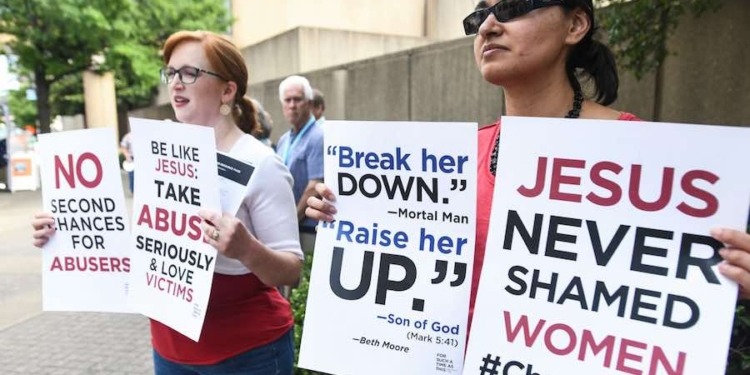The meeting comes at a fraught time in the nation’s largest Protestant denomination. Messengers — as voting delegates are known — will vote on whether to establish a constitutional ban on churches with women pastors. They’ll hear a report — and get outside criticism — of their handling of sexual abuse among their clergy.
With membership in steady decline, they’ll hear a report on how an earlier effort to reverse that trend fell short. And they’ll vote for a new president from among six candidates.
Speaking of presidential candidates, an outside group is inviting attendees to a virtual speech by former President Donald Trump, the presumptive Republican nominee, at an off-site event.
Proposed resolutions deal with topics ranging from Gaza to abortion and in vitro fertilization.
Here’s some of what’s facing the SBC:
What’s the latest with the sexual abuse crisis?
The convention has struggled to respond to sexual abuse in its churches since a 2019 report by the Houston Chronicle and San Antonio Express-News, saying that roughly 380 Southern Baptist church leaders and volunteers faced allegations of sexual misconduct in the previous two decades. A subsequent consultant’s report said past leaders on the convention’s Executive Committee intimidated and mistreated survivors who sought help.
But survivors and advocates say the denomination’s actions don’t match its promises of reform.
An Abuse Reform Implementation Task Force recently concluded its work. While it has provided a curriculum for training churches on preventing and responding to abuse, it has not achieved the mandate of previous annual meetings to establish a database of offenders, which could help churches avoid hiring them.
In a recent YouTube interview with a fellow pastor, the chairman of the SBC’s Executive Committee, Philip Robertson, sought to downplay reports that there was a “systemic problem” of abuse in the denomination, which he contended were “not true.” This has been a talking point for some outside critics of SBC efforts to respond to the crisis, now voiced by at least one person in SBC leadership. Robertson also said insurers warned they wouldn’t cover the denomination if it had the database, due to liability risks.
In response, the reform task force proposed having a separate nonprofit handle the list, but that has yet to materialize.
“Robertson’s remarks provide a window onto what has always been true,” said Christa Brown, a longtime advocate for fellow survivors of abuse within Southern Baptist churches, in an email. “SBC officials’ resistance to a database has always been about trying to minimize liability risks to the institution. … And SBC officials are trying to operate this multi-billion-dollar organization without taking on the inherent responsibilities that go along with it.”
In May, federal prosecutors charged Matt Queen, a former professor and administrator at an SBC-affiliated seminary in Texas, with providing federal investigators with a false document. The U.S. Attorney’s Office for the Southern District of New York asserted this document, involving an alleged case of sexual abuse by a seminary student, was provided with the intent to impede their investigation into sexual abuse within the convention.
The Executive Committee says it was told the federal investigation into its own actions has been completed.
Why would the SBC ban churches with women pastors?
In 2000, Southern Baptists amended the Baptist Faith and Message, their statement of doctrine, to say the office of pastor is limited to men, citing Bible verses such as one forbidding “a woman to teach or to have authority over a man.” This came amid a larger rightward push in the late 20th century SBC.
The doctrinal statement is nonbinding, and the denomination can’t tell its independent churches whom to call as pastor. Some churches with women pastors left, while others stayed but kept a low profile. Still others later appointed women pastors or allowed women to serve under male leaders in associate pastoral roles, citing biblical examples of women in ministry.
At this year’s meeting, messengers will vote on whether to give final approval to amending their constitution to ban churches — by deeming them not in “friendly cooperation” — with women pastors in lead or associate roles. The denomination preliminarily approved the amendment last year. That’s when it also began expelling congregations with women pastors, such as Saddleback Church, a California megachurch, on the grounds that they don’t closely identify with the Baptist Faith and Message. The amendment would codify an explicit ban on such churches, putting them in the same category as churches that “endorse homosexual behavior,” discriminate based on ethnicity or fail to address sexual abuse.
Why might this affect nonwhite churches more?
The National African American Fellowship, a caucus of predominantly Black congregations within the SBC, says an amendment barring churches with women pastors could disproportionately impact its members, many with women working in assistant pastor roles. Chinese and Hispanic Baptist fellowship leaders also say their churches could be affected because of language differences in how pastors are described.
Who are Southern Baptists?
The Southern Baptist Convention is the nation’s largest Protestant denomination. Members are overwhelmingly evangelical and conservative in religion and politics, the continuation of a rightward shift that began in the 1980s. The denomination was founded in 1845 in defense of slavery in a schism with northern Baptists. In 1995, the mostly white denomination formally repented of its support for slavery and other racism, and it made some strides to diversify racially. It has lost some Black churches and pastors in recent years due to alleged racial insensitivity within its overwhelmingly white leadership.
How’s it doing?
Southern Baptist membership has steadily declined since 2006 and is now below 13 million, its lowest since 1976. There are also long-term declines in baptisms — the prime metric of spiritual vitality.
Alarmed by such trends, Southern Baptists in 2010 approved a seven-point plan to reenergize evangelistic efforts. A task force, evaluating how that went, reported this year that only two of the goals were met, and that some were quickly forgotten.
The task force reported: “Regarding the simple question of whether or not the implementation [of the 2010 plan] reversed the decline of baptisms in the SBC, the answer is a clear and decisive, No.”
The report noted “a clear erosion of ‘trust, transparency and truth’ from within our convention which has ravaged our cooperative work.”
Who wants to lead the denomination?
Six men are being nominated to succeed Bart Barber, a folksy cattle farmer and small-church pastor, as president.
The candidates include five pastors and a seminary dean. As in recent years, the contest will be among candidates with varying degrees of conservativism.
Will there be politics?
Trump will speak virtually at a nearby event on Monday, the day before the annual meeting. That program includes some Southern Baptist leaders. It’s sponsored by an independent group but listed on the SBC calendar of events.
Former Vice President Mike Pence will speak Tuesday at a luncheon hosted by the Ethics and Religious Liberty Commission, but not in the main hall, as he did in 2018.
Messengers are expected to vote on resolutions supporting Israel and blaming Hamas amid the Gaza war; recommitting to the abolition of abortion; and urging parents diagnosed with infertility to carefully consider ethical options.






























Discussion about this post